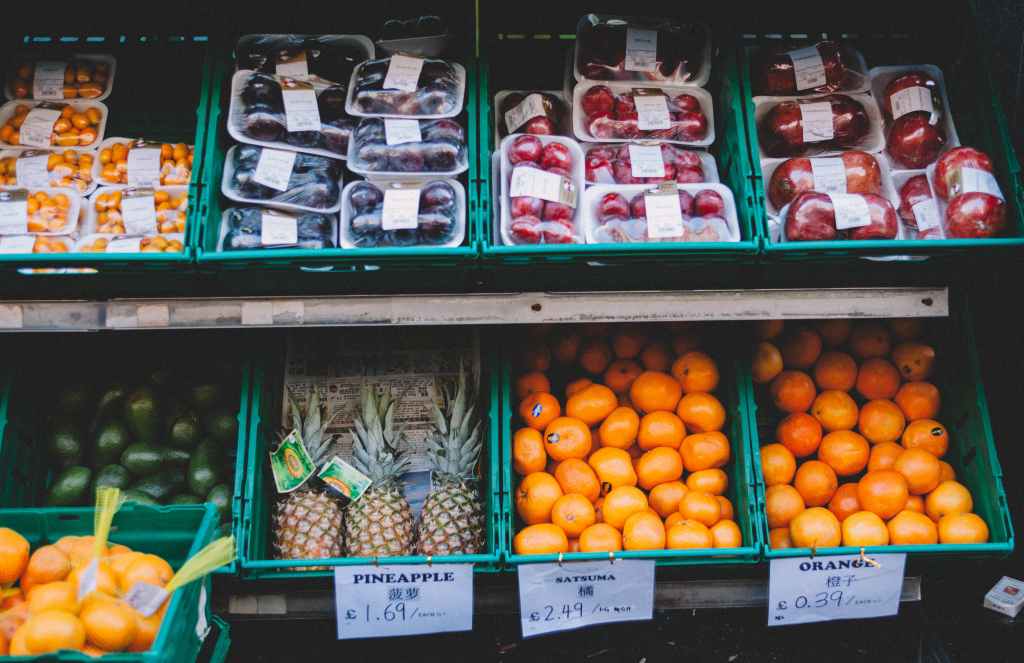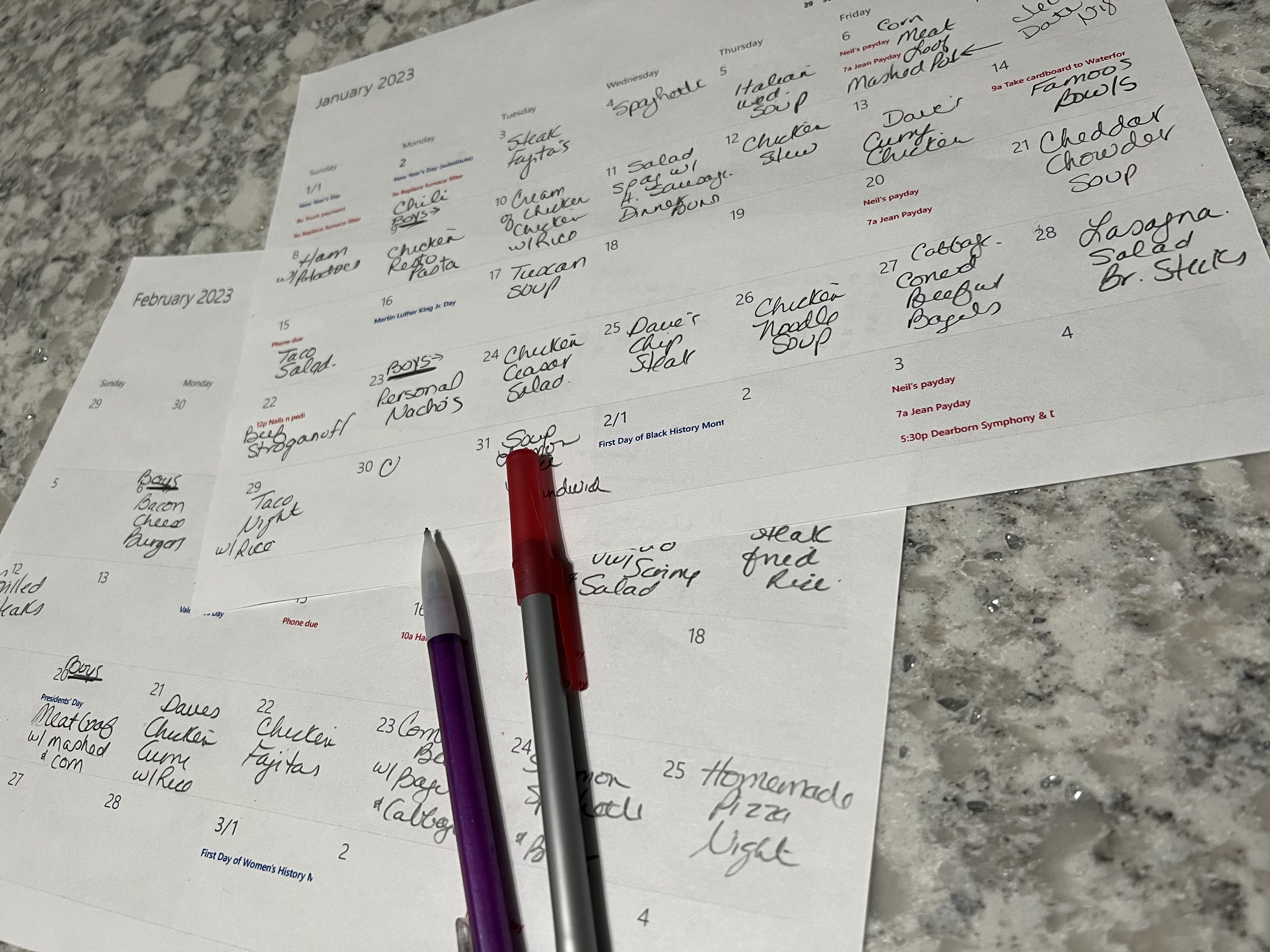
The Importance of Menu Planning & How it Will Save You Money!
I love to save money! You may not realize it, but we can spend so much more money on groceries when we don’t have a meal plan in action. In today’s blog I’m going to show you how important a monthly menu can be in saving you both time & money! Read on friends!
Menu planning is a crucial aspect of maintaining a healthy and organized lifestyle. By taking the time to plan out your meals in advance, you can save yourself both time and money while ensuring that you and your family are eating nutritious and delicious meals. One of the primary benefits of menu planning is that it helps you avoid the last-minute rush to figure out what to cook for dinner. With a well-thought-out plan, you can eliminate the stress of decision-making and have the ingredients you need readily available.
Check our my Menu Planning & Meal Prep blog from 2023 as well!
Benefits of Menu Planning
There are numerous benefits to incorporating menu planning into your routine. Firstly, it allows you to have a clear idea of what you will be eating throughout the week, which can promote healthier eating habits. By planning nutritious meals in advance, you are less likely to reach for unhealthy takeout options or resort to convenience foods. Menu planning also saves you time by reducing the need for multiple trips to the grocery store. With a comprehensive shopping list, you can ensure that you have all the necessary ingredients on hand, eliminating the need for last-minute dashes to the store.

Additionally, menu planning can help reduce food waste. When you plan your meals in advance, you can utilize leftovers and incorporate them into future meals, ensuring that no food goes to waste. This not only saves money but also promotes sustainability by reducing the amount of food that ends up in landfills. Lastly, menu planning can be a fun and creative process. It allows you to try new recipes, experiment with different flavors, and expand your culinary skills.
How Menu Planning Can Save You Money
One of the most significant advantages of menu planning is its potential to save you money. When you have a well-structured plan in place, you are less likely to make impulse purchases or buy unnecessary items at the grocery store. By sticking to your shopping list, you avoid buying items that may go unused and eventually end up in the trash. Menu planning also enables you to take advantage of sales and discounts. By planning your meals around the items that are on sale, you can stretch your budget further.
Another way menu planning saves you money is by reducing the number of times you eat out or order takeout. By having a plan for your meals, you are less likely to give in to the temptation of dining out or relying on expensive delivery services. Instead, you can enjoy home-cooked meals that are not only cost-effective but also tailored to your dietary preferences. Menu planning also allows you to buy in bulk and take advantage of larger package sizes, which often come at a lower price per unit.
Tips for Effective Menu Planning
- Take inventory of your pantry and refrigerator: Before creating your menu plan, assess what ingredients you already have on hand. This will help you avoid purchasing duplicates and ensure that you use up any perishable items before they go bad.
- Consider your schedule: Take into account your weekly schedule when planning your meals. Opt for quick and easy recipes on busy days and allow more time for elaborate dishes on days when you have more flexibility.
- Plan for leftovers: Incorporate meals that can be easily repurposed into your menu plan. This allows you to utilize leftovers and reduce food waste.
- Get creative with ingredients: Look for recipes that use similar ingredients, as this will help you make the most of what you have and prevent ingredients from going unused.
- Use theme nights: Assign specific themes to different nights of the week, such as Meatless Mondays or Taco Tuesdays. This adds variety to your menu plan and makes the planning process more enjoyable.
Creating a Weekly Meal Plan
Creating a weekly meal plan is an efficient way to ensure that you have delicious and nutritious meals throughout the week. Start by considering your family’s dietary preferences and any dietary restrictions you may have. Take into account the number of meals you need to plan for, including breakfast, lunch, dinner, and snacks. Once you have a clear idea of your requirements, begin selecting recipes that align with your preferences and fit within your schedule.

To make the process easier, consider utilizing online meal planning tools or smartphone apps that provide recipe ideas and generate shopping lists. These tools can help streamline the menu planning process and save you time. When creating your meal plan, be sure to include a variety of foods from different food groups to ensure a balanced diet. Also, take into consideration any special occasions or events that may require additional preparation or specific meals.
Once your meal plan is complete, write it down or print it out and display it in a visible location, such as on your refrigerator. This serves as a helpful reminder and makes it easier to follow through with your plan. Remember, flexibility is key. If unexpected events arise or you find yourself with extra leftovers, be prepared to make adjustments to your meal plan accordingly.

Sign up for updates
Utilizing Leftovers in Your Meal Planning
Leftovers can be a valuable asset when it comes to menu planning. Not only do they save you time and effort, but they can also help you stretch your budget further. There are several strategies you can employ to make the most of your leftovers. One option is to plan for specific leftover nights in your meal plan. For example, designate a night each week as “Leftover Night” and enjoy a buffet-style dinner using the leftovers from previous meals.

Another strategy is to repurpose your leftovers into entirely new dishes. For example, leftover roasted chicken can be transformed into a delicious chicken salad or added to a stir-fry. Get creative with your leftovers and experiment with different flavor combinations to keep your meals exciting and enjoyable. Additionally, consider freezing leftovers in individual portions. This allows you to have quick and easy meals on hand for busy days or times when you don’t feel like cooking from scratch.
Shopping Smart for Your Menu Plan
Smart shopping is an essential component of successful menu planning. By following a few key strategies, you can maximize your savings and make the most of your budget. Firstly, always shop with a list. Create a comprehensive shopping list based on your menu plan and stick to it. This will help you avoid impulse purchases and ensure that you have all the necessary ingredients. Additionally, try to shop when you are not hungry, as this can help you resist the temptation to buy unnecessary snacks or treats.

Consider shopping at discount grocery stores or using coupons to further reduce your grocery bill. These stores often offer significant savings on everyday items and can help stretch your budget. Another tip is to buy in bulk when possible. Items such as rice, pasta, and canned goods can often be purchased in larger quantities at a lower price per unit. Just be sure to check the expiration dates and ensure that you have enough storage space.
Lastly, consider purchasing items that are in-season. Seasonal produce is typically more affordable and often tastes better. Plan your menu around the fruits and vegetables that are currently in season to take advantage of their freshness and lower prices.
Budget-Friendly Recipe Ideas
When it comes to menu planning on a budget, it’s important to choose recipes that are cost-effective yet still delicious and nutritious. Here are a few budget-friendly recipe ideas to get you started:
- Vegetable stir-fry: A stir-fry is a versatile and budget-friendly option. Use a variety of vegetables, such as bell peppers, broccoli, and carrots, and pair them with a protein of your choice, such as tofu or chicken. Serve over rice or noodles for a satisfying meal.
- Bean and vegetable soup: Soups are an excellent way to use up leftover vegetables and stretch your budget. Combine a variety of canned or dried beans with vegetables, broth, and seasonings for a hearty and nutritious meal.
- Sheet pan dinners: Sheet pan dinners are not only convenient but also cost-effective. Simply toss your choice of protein, such as chicken or fish, with vegetables and seasonings on a sheet pan, and roast until cooked through. Serve with a side of rice or potatoes for a complete meal.
- Pasta with homemade sauce: Pasta is a budget-friendly staple that can be paired with a variety of homemade sauces. Make a simple tomato sauce by sautéing onions, garlic, and canned tomatoes. Add herbs and seasonings to taste, and serve over your favorite pasta shape.
- Egg-based dishes: Eggs are an affordable source of protein and can be used in a variety of dishes. Whip up a frittata or omelette using leftover vegetables and cheese, or make a simple scrambled egg dish with your choice of herbs and spices.
Resources for Meal Planning and Saving Money
If you’re looking for additional guidance and inspiration for menu planning and saving money, there are several resources available to assist you. Online platforms such as Pinterest and food blogs are excellent sources of recipe ideas and meal planning tips. Many websites also offer free printable meal planners and shopping lists to help you stay organized.
Additionally, consider joining online communities or forums dedicated to meal planning and budget-friendly cooking. These communities often share valuable tips, recipes, and strategies for success. You can also find budget-friendly cookbooks or eBooks that provide meal plans and recipes designed specifically for saving money.
Lastly, don’t underestimate the power of your local library. Many libraries have a wide selection of cookbooks and resources that you can borrow for free. Take advantage of these resources to expand your culinary knowledge and find new recipe ideas.

In conclusion, menu planning is a valuable tool that can help you save money, eat healthier, and reduce food waste. By taking the time to plan your meals in advance, you can avoid the stress of last-minute decision-making, make the most of your ingredients, and ensure that you have nutritious and delicious meals throughout the week. Incorporate tips such as taking inventory of your pantry, utilizing leftovers, and shopping smart to maximize your savings. Remember to be flexible and enjoy the process of menu planning by trying new recipes and flavors. With these simple tips and tricks, you can make menu planning a breeze and reap the benefits of a well-organized and budget-friendly meal plan.
CTA: Start saving time and money today by incorporating menu planning into your routine. Take the first step by creating a simple weekly meal plan and see the difference it can make in your life.
If you enjoyed this blog , please LIKE, Follow, Share & leave me a comment! I love your feedback!
If you aren’t following me on Facebook & Instagram, go on over & give a LIKE & Follow me for daily tips & tricks for your home & garden!
Remember to eat fresh, shop local, & have a happy day,
Jean
Copyright Policy
All text and images on this site are copyright of For Dragonflies And Me. Unless otherwise noted, you may not use this content
This post may contain affiliate links. If you choose to purchase through an affiliate link, I may receive a small commission at no additional cost to you. You can see my full disclaimer here.



